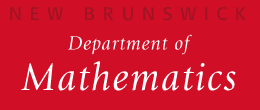General Information
Topics: Markov chains: definition, transition probabilities, special Markov chains (random walks, dams and inventories, branching processes), classification of states, limit theorems. Poisson processes: derivations, homogeneous, non-homogeneous processes, spacial and marked Poisson processes. Continuous time Markov chains: the Chapman-Kolmogorev equation, birth and death processes, the case of a finite state space, special cases, limiting behavior. Renewal processes: definition, the renewal function, replacement models, renewal theorems, inspection paradox, applications. Brownian motions: definition, processes with independent increments, the maximum variable and the reflection principle, Brownian bridge, geometric Brownian motion, applications in modern financial theory. Queueing theory: queueing systems, Little's formula, Poisson arrivals and exponential and general service times, the case of an infinite number of servers, priority queues, queueing systems.
Prerequisites: Math 477 (Mathematical Theory of Probability) or Statistics 381 (Theory of Probability).
Fall 2019 Schedule
This course is taught each Fall Semester.
New Textbook
Introduction to Probability Models, Sheldon M. Ross, 10th Edition, Academic Press, 2006 (800 pp.); (ISBN: 978-0-12-37486-2 )
There will be a new sample syllabus, similar to the old one, but adjusted to the new text.
Syllabus
Consult the instructor for the syllabus for a given term. The sample syllabus found here is typical. However assignments, grading policy, and content are all governed by the syllabus provided by the instructor.
Archives
Previous semesters:
- Fall 2008. Prof. Jeong
- Fall 2007: Mine Subasi
- Fall 2004 (Prof. Prekopa, RUTCOR)
Textbook used through Fall 2008:
Samuel Karlin, Edited by Howard E. Taylor; Title: An Introduction to Stochastic Modeling (third edition); Academic Press, 1998; (ISBN: 0-12-684887-4; ISBN13: 978-0-12-684887-8 )
Disclaimer: Posted for informational purposes only
This material is posted by the faculty of the Mathematics Department at Rutgers New Brunswick for informational purposes. While we try to maintain it, information may not be current or may not apply to individual sections. The authority for content, textbook, syllabus, and grading policy lies with the current instructor.
Information posted prior to the beginning of the semester is frequently tentative, or based on previous semesters. Textbooks should not be purchased until confirmed with the instructor. For generally reliable textbook information—with the exception of sections with an alphabetic code like H1 or T1, and topics courses (197,395,495)—see the textbook list.








